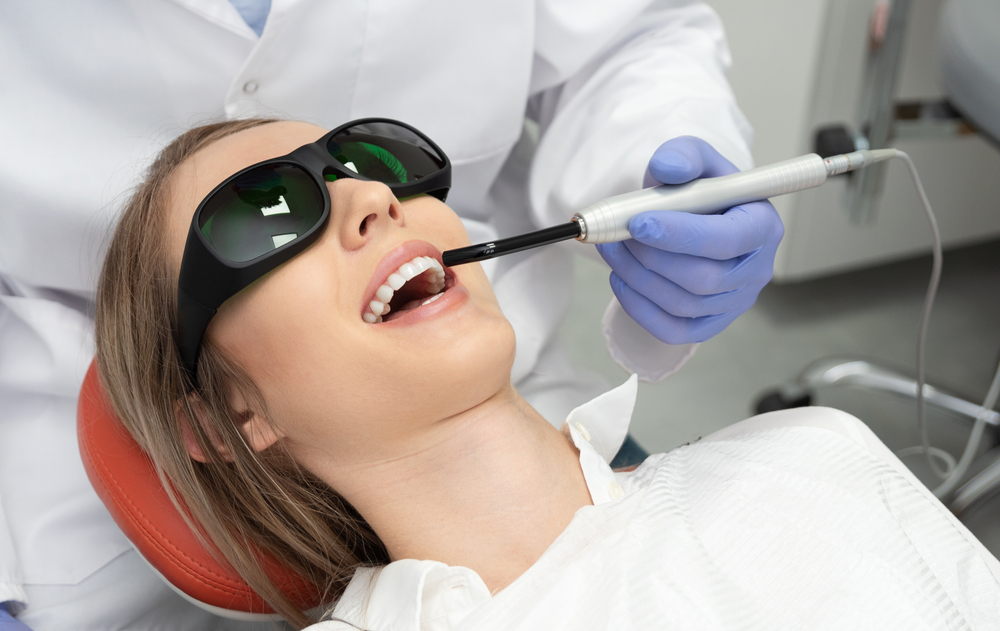In the world of family dentistry, advancements in technology continually enhance the quality and comfort of dental care. One of the most exciting developments in recent years is the use of lasers in dental procedures. This cutting-edge technology offers numerous benefits, from making treatments less invasive and more precise to reducing recovery times and enhancing patient comfort. Whether it’s for routine cleanings, cavity removal, or cosmetic enhancements, lasers are transforming the way dental care is delivered. In this blog, we’ll explore the role of lasers in dental procedures, highlighting how this innovative approach can improve the oral health and well-being of your entire family.
In This Blog:
- What are Dental Lasers and How Do They Work?
- Advantages of Laser Technology in Dentistry
- Applications of Dental Lasers
- What to Expect When Receiving Treatment with a Dental Laser
What Are Dental Lasers and How Do They Work?
Dental lasers are advanced instruments that emit a concentrated beam of light energy. This laser light can be precisely controlled and manipulated to interact with various tissues in the mouth. Dental lasers come in two main types based on their application:
- Hard Tissue Lasers: These lasers are used on teeth and bone, and are ideal for procedures such as cavity preparation and tooth sensitivity treatment.
- Soft Tissue Lasers: These are used on the gums and other soft tissues. Types include Diode lasers and Carbon Dioxide (CO2) lasers. They are commonly used for gum reshaping, treating gum disease, and other soft tissue procedures.
The operation of dental lasers is based on the principles of light energy absorption and tissue interaction. Lasers produce a focused beam of light at a specific wavelength, chosen based on the type of tissue being treated to ensure optimal absorption and effectiveness. This light interacts with the target cells, enabling precise cutting, vaporization, or shaping of the tissue while simultaneously sterilizing the area and reducing the risk of infection.
Advantages of Laser Technology in Dentistry
The use of lasers in dental procedures offers several significant advantages:
- Minimally Invasive: Lasers provide a less invasive option compared to traditional dental tools, resulting in less pain and discomfort for patients.
- Reduced Bleeding and Swelling: The coagulating effect of lasers minimizes bleeding and reduces post-operative swelling.
- Faster Recovery: Patients often experience quicker healing times due to the reduced trauma to tissues.
- Lower Risk of Infection: The sterilizing effect of the laser reduces the risk of post-treatment infections.
- Greater Precision: Lasers enable dentists to target specific areas accurately, preserving more healthy tissue and achieving better outcomes.
By understanding what dental lasers are and how they work, patients can better appreciate the benefits of this cutting-edge technology in modern dental care. Whether for cosmetic procedures, treating gum disease, or other dental treatments, lasers offer a safer, more comfortable, and highly effective solution.
Applications of Dental Lasers
Soft Tissue Procedures
Gum Reshaping and Contouring:
Lasers can precisely remove excess gum tissue to create a more aesthetically pleasing gum line. This procedure results in minimal bleeding and faster recovery compared to traditional methods involving scalpels.
Treatment of Gum Disease (Periodontal Therapy):
Lasers remove infected gum tissue and bacteria from periodontal pockets, reducing inflammation and promoting healthier gums. This non-invasive approach is less painful and has a quicker recovery time.
Frenectomy and Treatment of Tongue-Tie:
Lasers perform frenectomies quickly and efficiently, with minimal pain and bleeding. This is particularly beneficial for children with tongue-tie, improving their ability to eat and speak.
Removal of Benign Oral Tumors and Lesions:
Lasers allow for the precise removal of benign tumors and lesions with minimal damage to surrounding tissues. The procedure is less invasive, with reduced risk of infection and faster healing.
Hard Tissue Procedures
Cavity Detection and Removal:
Lasers can detect and remove cavities early, preserving more of the natural tooth structure. The procedure is often painless and does not require anesthesia.
Tooth Preparation for Fillings:
Lasers can prepare a tooth for a filling by precisely removing decayed tissue, reducing the need for anesthesia and preserving more healthy tooth structure.
Treatment of Tooth Sensitivity:
Lasers can seal the tubules on the root surface of sensitive teeth, providing immediate relief from sensitivity to hot, cold, or sweet stimuli.
What to Expect When Receiving Treatment with a Dental Laser
Initial Consultation
Before undergoing any dental laser treatment, you’ll first have a consultation with your dentist to evaluate your oral health, discuss treatment options, and create a personalized treatment plan.
Preparation for the Procedure
On the day of your laser treatment, you may receive special protective glasses and, if necessary, a local anesthetic to ensure your comfort.
The Laser Treatment Procedure
The laser treatment is straightforward and involves identifying the target area, applying the laser with minimal discomfort, and precisely treating the affected tissues.
Post-Treatment Care
After the procedure, your dentist will provide instructions for post-treatment care, including pain management, oral hygiene, and any necessary dietary guidelines. Recovery is typically quick, with minimal discomfort and faster healing.
Conclusion
Laser technology has significantly transformed the field of dentistry, offering a range of benefits that enhance both the effectiveness of treatments and the overall patient experience. From minimally invasive procedures and reduced need for anesthesia to faster healing and increased precision, dental lasers have revolutionized the way oral health issues are addressed. Compared to traditional methods, laser dentistry provides superior outcomes with less discomfort and quicker recovery times. As this technology continues to advance, its applications in dental care are expected to expand even further, making treatments more efficient and accessible. If you’re considering a dental procedure, discussing the potential advantages of laser dentistry with your dentist can help you make an informed decision about your oral health. Embrace the future of dental care with confidence, knowing that laser technology is paving the way for a brighter, healthier smile.



